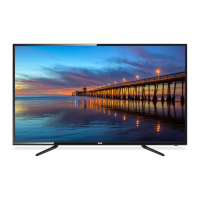
Do you have a question about the RCA RLDED5098-UHD and is the answer not in the manual?
Basic operations for navigating the TV menu system and selecting options.
Instructions on using arrow and ENTER buttons to select desired modes.
Guidance on pointing the remote at the sensor and optimal operating distance.
Instructions for installing new batteries and precautions for replacement.
Covers buttons like Standby, Mute, Number keys, and volume/channel controls.
Explains buttons for Picture Mode (PMODE), Sound Mode (SMODE), and MTS.
Details buttons for Sleep, Source, Aspect Ratio, Info, EPG, and Menu navigation.
Details the Power Cord, Headphone Jack, and Coaxial Out Jack.
Describes AV/YPbPr/Audio In, VGA In, and PC Audio In jacks.
Identifies the TV Antenna Terminal, Service Port, and HDMI In Jacks.
Details the POWER and SOURCE buttons for turning on/off and input selection.
Describes the MENU, CH+/CH- buttons for accessing menus and changing channels.
Explains the VOL+/VOL- buttons for adjusting the audio volume.
How to connect devices using composite yellow RCA-type video and audio cables.
Guide on setting up digital output via SPDIF, including Raw or PCM selection.
Instructions for safely attaching or detaching the TV's base stand.
Details for wall-mounting, including VESA compliance and screw specifications.
Guidelines for placing the TV on a stable surface, avoiding hazards.
Instructions for turning the TV on for the first time and running channel auto scan.
How to select the desired input source for the TV.
Steps for setting up the TV when connected to an indoor or outdoor antenna.
Steps for setting up the TV when subscribed to a pay television service.
Instructions for selecting auto scan and starting the channel search.
Choosing picture modes like Standard, Dynamic, Mild, User, or Power Saving.
Detailed adjustments for Contrast and Brightness in the USER mode.
How to adjust color intensity and tint towards green or red.
Adjusting sharpness for crisper edges and color temperature (Cool, Normal, Warm).
Choosing zoom modes like Wide, Normal, Zoom, or Cinema for content display.
Choosing sound modes like Standard, Music, Movie, Sports, or User.
Adjusting low frequency (Bass) and high frequency (Treble) intensity.
Adjusting speaker balance and enabling/disabling surround sound effect.
Configuring AVC, digital output type (SPDIF), and selecting audio broadcast language.
Setting the auto-off timer for the TV in increments from 5 minutes to 240 minutes.
Selecting the local time zone and enabling or disabling daylight saving time.
Setting the menu language and controlling screen transparency.
Adjusting noise reduction levels and toggling the DLC feature.
Configuring PC input settings like H-POS, V-POS, Clock, and Phase.
Adjusting horizontal and vertical image position for PC input.
Controlling image width (Clock) and improving focus/stability (Phase).
Using the AUTO button to automatically adjust PC display settings.
Configuring CC modes, basic selection, advanced selection, and options for text customization.
Toggling DLC feature and selecting display mode between Home and Standard.
Selecting HDMI input standard and restoring TV settings to factory defaults.
Setting up a password and enabling the system lock for parental controls.
Information on RRT Setting and Reset RRT, noted as not user adjustable.
Selecting US TV ratings (TV-Y, TV-PG, TV-14, TV-MA) and their definitions.
Choosing MPAA movie ratings (G, PG-13, R, NC-17) and understanding their definitions.
Selecting Canadian English TV ratings and their descriptions.
Selecting Canadian French TV ratings and their descriptions.
Adding or deleting channels from the favorites list using the ENTER button.
Selecting channels to show or hide, changing their status with the ENTER button.
Naming or renaming broadcast channels using on-screen keyboard.
Using Normal mode for native content and Wide mode to stretch 4:3 content.
Applying Zoom mode to fill screen and Cinema mode to eliminate black bars.
Notes on unsupported modes, potential display disturbances, and power management.
Notes on related AV devices, connection instructions, and format incompatibilities.
Details on panel type, size, resolution, brightness, contrast, and system features.
Specifications for various input/output jacks and power requirements.
Troubleshooting bad picture, no sound, or black and white picture problems.
Resolving issues like no picture/sound, unresponsive keys, and hot panels.
Addressing screen stripes, hot monitors, channel selection issues, and power-on display disorder.